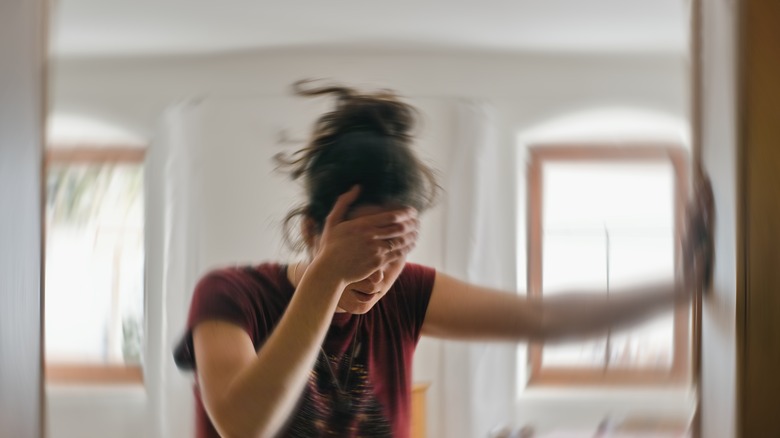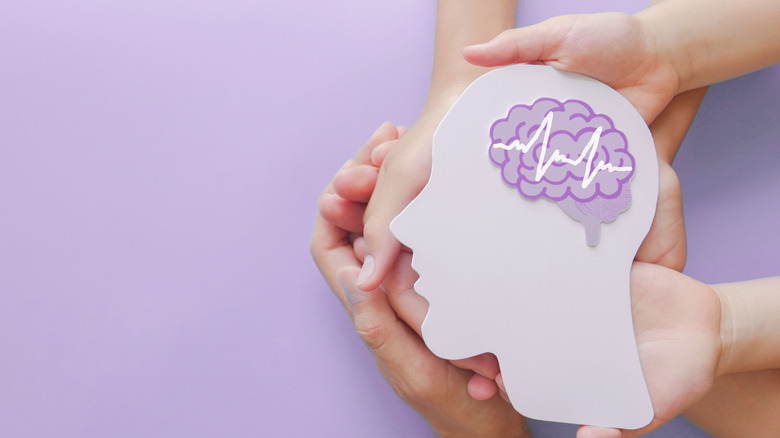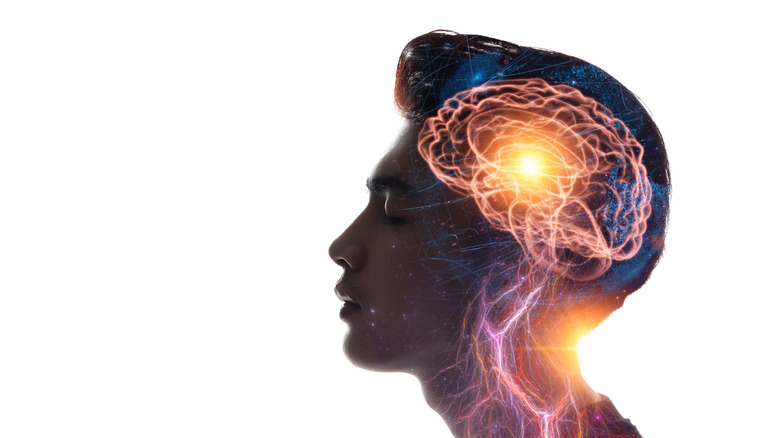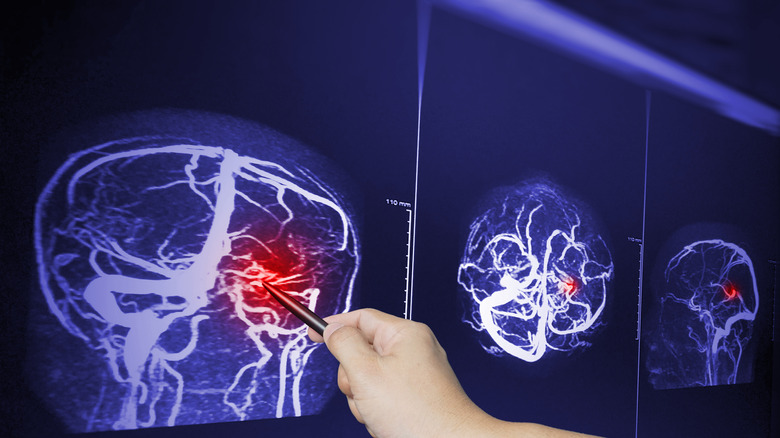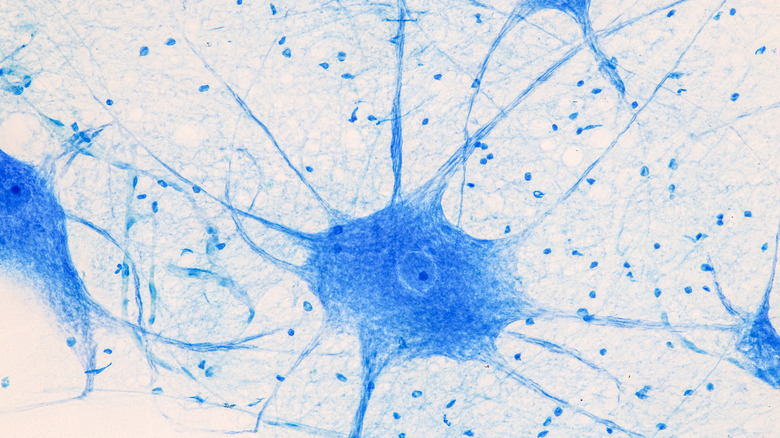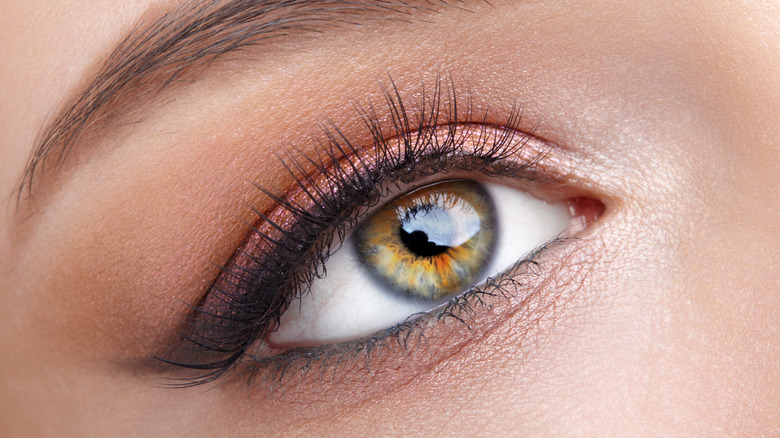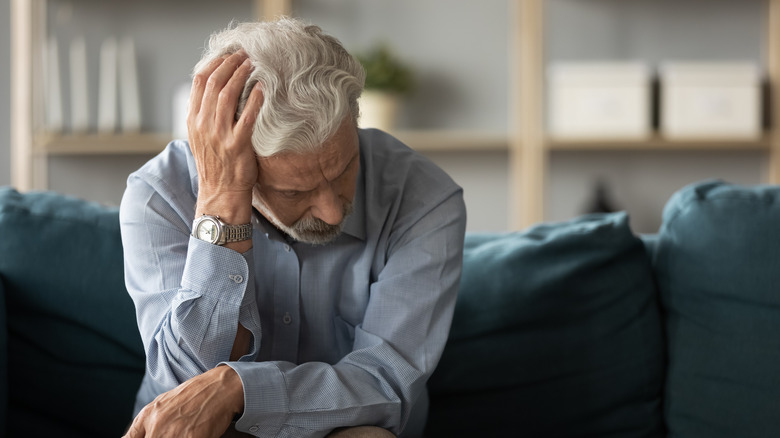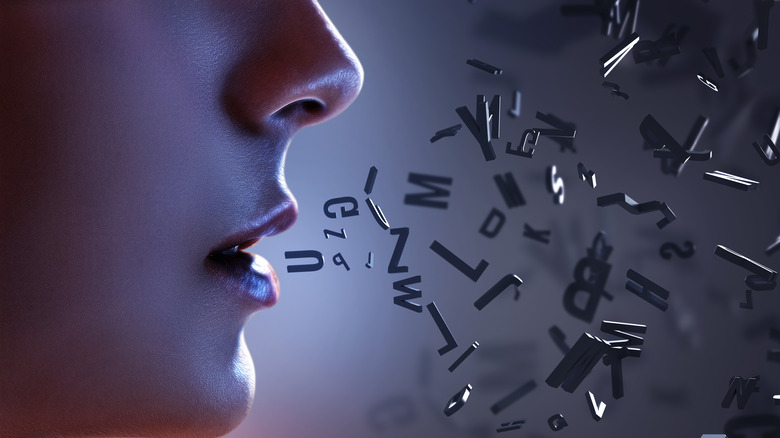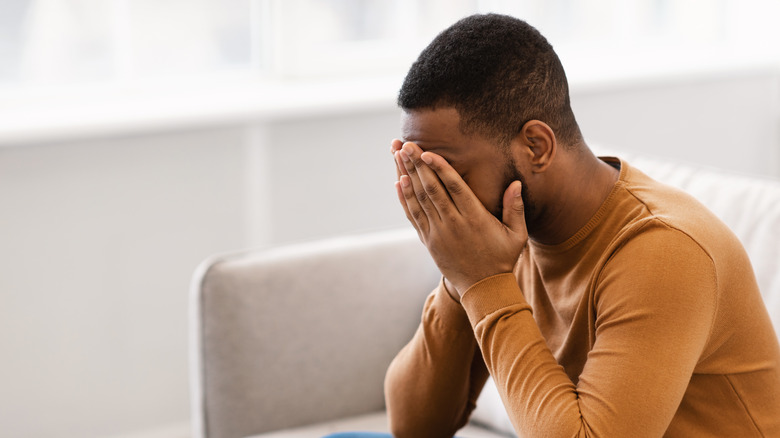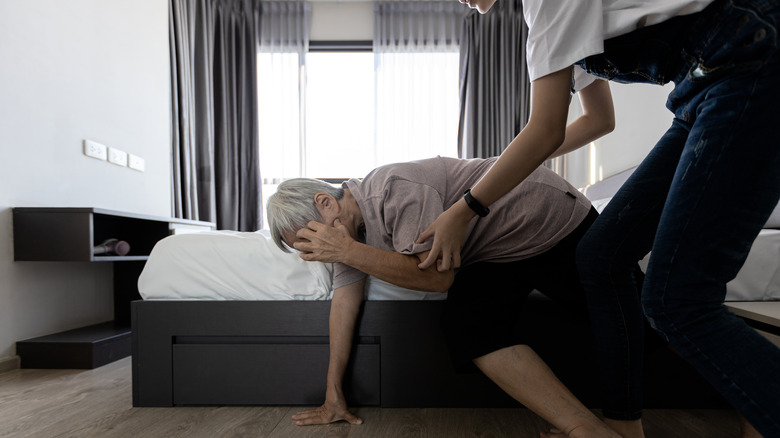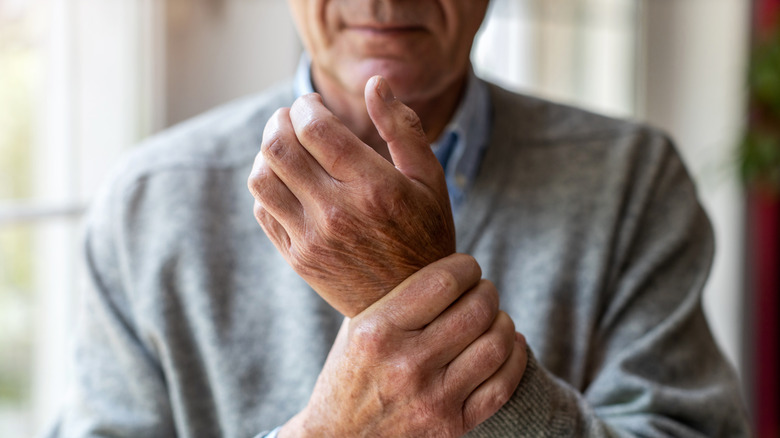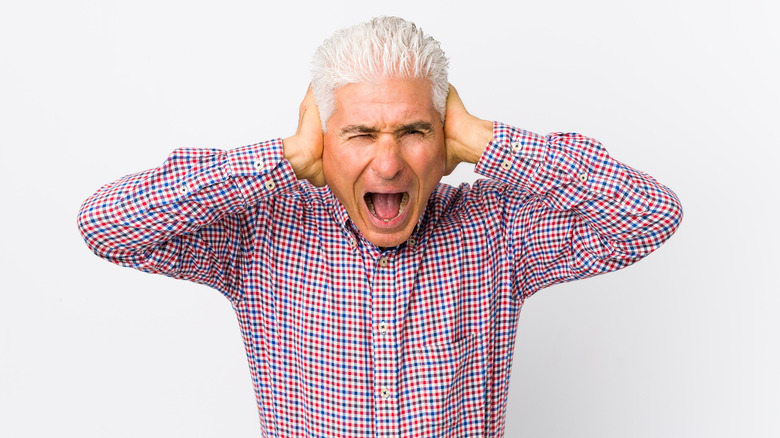When You Have A Stroke, This Is What Happens To Your Body
When something goes wrong with your body, it can be hard to act calmly and think clearly. Particularly if you don't know what's happening, an emergency situation can get out of hand quickly. Strokes can be quite frightening, since the symptoms can be so strange. According to the Centers for Disease Control and Prevention (CDC) roughly 93% of people knew that going numb on one side of the body was a sign of stroke, but only 38% knew of all major symptoms.
Stroke is one of the leading causes of death in the United States, according to the CDC. Almost 800,000 people have a stroke each year in the U.S., and it's a leading cause of disability. Stroke is often the result of cardiovascular disease, which is a condition that develops over time.
Learning more about what happens to your body during a stroke can help you identify the symptoms in yourself or someone else. The sooner you get help the better. And remember this: "Patients who arrive at the emergency room within three hours of their first symptoms often have less disability three months after a stroke than those who received delayed care," notes the CDC.
A clot blocks blood to the brain
There are multiple causes of stroke, but one of the most common is known as an embolic stroke. It's a type of ischemic stroke in which a blood clot "forms in one part of the body" and then travels to the brain, according to the National Heart, Lung, and Blood Institute.
Plaque buildup in your blood vessels is known as atherosclerosis. This buildup happens slowly over the course of your life, explains the American Heart Association. There's no direct proof of what causes plaque to accumulate, but a leading theory is that damage to the walls of your blood vessels triggers clotting materials, such as cholesterol and fatty substances, to seal the wound. This seal is known as plaque, and as it accumulates it narrows your blood vessels, leaving less room for blood to flow.
If a piece of this plaque breaks off, it can travel through your blood vessels and get jammed, blocking the flow of blood to parts of your body. The heart, lungs, and brain are all at risk. When these floating bits of plaque cut off blood to your brain, it results in a stroke.
An artery in the brain breaks open
Blood clots aren't the only thing that causes stroke. You can also have bleeding in the brain that causes swelling. This swelling pushes on the brain cells and can cause damage, explains the National Heart, Lung, and Blood Institute.
Brain aneurysms are a cause of bleeding in the brain. They're caused by a weakened blood vessel wall in the brain, according to the National Health Services (NHS). An aneurysm can happen in other blood vessels in the body as well. You can have one in your brain and never experience symptoms, but once it ruptures, you can have a stroke.
You can also have more mild symptoms from a brain aneurysm rupturing — for example, a headache and stiff neck (per NHS). Doctors might not treat an aneurysm before it bursts, but getting medical attention is important if it does. Some of the causes of aneurysms include smoking, high blood pressure, age, and a major head injury — even family medical history could make you more susceptible to having an aneurysm, although these are rare instances.
Bleeding inside the brain
While an aneurysm causes bleeding between the skull and brain, there's another type of bleeding that can cause stroke: intracerebral hemorrhage. According to the American Association of Neurological Surgeons (AANS), this can be caused by something as simple as high blood pressure wearing down blood vessels in the brain over time.
Intracerebral hemorrhage is the second most common type of stroke, explains the AANS. Symptoms can include vision loss, seizures, and weakness or numbness in the face, arm or leg. Bleeding inside the brain can cause brain damage and stroke in two ways. The blood itself can damage brain cells, and the increased swelling in the skull caused by bleeding can cause brain damage. This type of stroke is more common in older men with high blood pressure, particularly if they're using illegal drugs like cocaine. Using blood thinners can also make you more likely to have bleeding in the brain.
If you don't have a serious case of bleeding in the brain, there are non-surgical treatment options, such as blood pressure control medication. However, you might need surgery to treat the hemorrhage. The AANS says, "Seek medical care immediately when neurological symptoms occur. Hemorrhages often enlarge within [the] first three hours in at least 33% of cases and volume of hemorrhage correlates highly with outcomes."
Brain cells die
The biggest danger of a stroke is the death of brain cells, according to the Centers for Disease Control and Prevention (CDC). Your brain controls vital functions such as heart rate, blood pressure, and breathing. Damage to any part of your brain can take away vital functions or things like your ability to communicate. If oxygen-rich blood can't get to your brain because one of your arteries is blocked, brain cells can begin to die almost immediately (via the CDC).
And while it was once thought that you had a set amount of neurons through the course of your life, according to The National Institute of Neurological Disorders and Stroke (NIH) scientists now say, "Although the majority of neurons are already present in our brains by the time we are born, there is evidence to support that neurogenesis (the scientific word for the birth of neurons) is a lifelong process." New neurons are formed in one part of the brain, then travel to a specific part to play a specific role — this is what's referred to as migration. Though scientists also believe that only about one third of migrating neurons reach their destination. And the NIH adds "large numbers of them die during migration and differentiation."
Sudden numbness in parts of your body
If you're going through your day and suddenly feel a strange numbness in part of your body, it could be a warning sign of stroke. According to the CDC, you could feel it on one side of the body, or in a specific area like the face.
Another term for numbness and tingling in parts of your body is paresthesia, notes the National Institute of Neurological Disorders and Stroke. Paresthesia can manifest as a "pins and needles" sensation, tingling, and even burning. Many people have experienced paresthesia in some form or another over the course of their lives. It's not always dangerous. For example, when you rest in an awkward position and your foot falls asleep, you're experiencing temporary paresthesia.
Someone who's having a stroke might experience paresthesia suddenly. It's also a common symptom of something called a transient ischemic attack (TIA), which is a more mild and temporary form of a stroke. Here's what to look for: dizziness, numbness (weakness) on one side of your body, loss of balance, and visual impairment (per MedlinePlus).
Your vision can be disrupted
Perhaps one of the more frightening and apparent symptoms of stroke is a loss of or change in vision. According to Johns Hopkins Medicine, one or both of your eyes can be affected. It might seem strange that an injury to your brain could change your eyesight, but vision is only partially in your eyes. The other part is the brain, which interprets and makes sense of the images your eyes collect. "Visual processing occurs in the occipital lobe as well as the temporal and parietal lobes," notes Johns Hopkins Medicine. That means damage to the brain can have a significant impact on what you see.
And so, the portion of your brain that's largely responsible for vision is called the occipital lobe, located toward the back of the brain. There are other areas of the brain that help with vision, but this is the main area. If the left side of the brain is damaged, you can have trouble seeing to the right, and vice versa. That's because the brain often controls things on the opposite side of the body. With regard to the impact on vision, Johns Hopkins Medicine adds, "After a stroke or brain injury, the changes that a patient experiences can be permanent or there can be improvement over time."
You can develop headaches
While they're largely a nuisance (and can be caused by things that are sort of innocuous, like a hangover) headaches can also be the sign of a serious problem. According to Johns Hopkins Medicine, a sharp headache that appears out of nowhere can be a sign of a stroke.
A study published in Neurology examined the occurrence of headaches in people who have ischemic strokes, which block blood flow to the brain. They found that roughly 6% to 44% of people who have this type of stroke complain of headaches as a symptom. The authors determined that headaches weren't simply a random event that occurred around the time of a stroke, but a direct result of the stroke.
The researchers explain that the headaches you get from a stroke are different from a migraine. Stroke headaches are often caused by a lack of blood flow to the back of the brain. Most people have headaches from one to four days around the event of their stroke. A small but still significant amount of people have it for months or years after.
Problems thinking or remembering
Since a stroke affects the brain, it might not be surprising that you can have problems thinking or remembering things during or after a stroke. The Heart & Stroke Foundation of Canada describes this as vascular cognitive impairment. At its most extreme, vascular cognitive impairment can turn into vascular dementia, which mimics the symptoms and severity of dementia.
Vascular cognitive impairment can "affect your mind's executive functions. These are a set of mental processes to help you problem solve and get things done" (via Heart & Stroke Foundation of Canada). Multi-tasking, decision making, reasoning, and planning are part of your executive functions.
A study published in BMC Neurology examined the likelihood of problems thinking and remembering within six months after a stroke. The researchers found that it was relatively common for people to have cognitive problems within six months, but that rehabilitation programs could lessen their symptoms and make it less likely that they develop dementia. The scientists also found that giving patients medications to reduce blood pressure and the chance of blood clots, which prevents stroke, also helped their cognitive function.
Speaking can become difficult
So, we've covered some of the effects of stroke that can be felt immediately, such as headache and numbness or tingling in parts of your body. Trouble communicating is another symptom that can develop during or after a stroke. The Cleveland Clinic lists this as one of the many disabilities that can result from a stroke, along with the inability to even understand words.
According to a study published in Stroke, roughly a third of people that survive a stroke develop something called aphasia. This is the official term for problems reading, writing, speaking, or understanding speech after an incident impacting the brain. This is one of the harder forms of disability to deal with after a stroke, since it impacts so many areas of life. For example, people with aphasia report worse mental well-being and ability to hold a job (or return to work) after stroke (via Stroke).
Starting treatment for aphasia early after it develops helped people recover faster, and researchers at Stroke also add "although recovery continued to be observed to a lesser extent beyond 6 months poststroke."
A change in personality
By now, you know that some of the effects of stroke are more obvious — a headache or change in vision is immediately tangible, for example. Other things, such as a change in personality, might be difficult or impossible to perceive. According to the Cleveland Clinic, it's one of the possible long-term effects of a stroke.
One possible (personality) change from a stroke is apathy, explains the American Stroke Association. Someone who is apathetic doesn't seem to care about much. This can seem similar to depression, which medical professionals can help using medication and therapeutic interventions. Another, somewhat puzzling change is neglect. But in this case, it doesn't mean neglecting to pay attention to loved ones. People with strokes on the right hemisphere of the brain can essentially ignore the left side of their body or things in their left field of vision. "Neglect can run the gamut from someone who doesn't recognize paralyzed limbs as their own to those who ignore food on one side of the plate or words on one side of the page," explains the American Stroke Association.
People with personality changes from stroke can benefit greatly from social support. Loved ones can help someone with neglect by pointing out things they don't seem to notice. The American Stroke Association adds, "For example, talking to them from their affected side helps them to focus and concentrate on that side." This kind of conscious encouragement helps the patient diminish their neglect.
Your balance is thrown off
During or after a stroke, you might find that it's hard to walk straight or move well. You might stumble more than usual or feel dizzy. That's because a stroke can affect your coordination and ability to balance, according to Mount Sinai.
The Stroke Association explains that balance is a complex and coordinated effort by the body. Your ears, brain, muscles, and joints are all involved. Since so many different systems are working together, a stroke can make balancing more difficult in a number of ways. For example, a stroke can make some of your muscles weak. If your right leg is weaker it can affect your ability to put pressure on it or react quickly. Or, you can have weakness that affects your ability to move your foot to react to things like stepping off a curb.
Another possibility is that the cerebellum, a region of the brain that controls balance, is damaged. If this happens, you can feel dizzy and develop vertigo, which makes it seem as though you are spinning. Also, if your eyesight is damaged from a stroke it can make balance difficult, since your eyes help you perceive the world around you. If you have trouble balancing, movement therapy will be important in regaining control — intensive and individual balance and retraining exercises will help during recovery.
Symptoms on the opposite side of the body
Strokes can cause damage to many different parts of the brain. To make things even more complicated, damage to one side of the brain can cause problems on the opposite side of the body, explains the American Association of Neurological Surgeons. While symptoms on the same side of the body are rare, they can occur. A study published in Acta Neurologica Scandinavica found that a small percentage of people, usually those who'd had strokes before, suffered weakness on the same side of the body as the damage in their brain.
An even more curious phenomenon is the way the brain remodels itself after a stroke. A study published in NeuroSciences found that stroke patients brains could "reorganize" themselves on the uninjured side. For example, if someone had a stroke that damaged the right side of the brain and caused symptoms on the left side of the body, the left side of their brain would partially remodel itself to regain some control over the left side of the body.
Muscles become tight and stiff
A stroke can change the way you move, including how effective your muscles are. A majority of people in the United Kingdom who have strokes also develop weakness in the legs, reports the Stroke Association. That can make things like walking or going up stairs very challenging. There's also a condition called foot drop that makes the muscles in your shin and foot weak. When this happens you can't lift up your foot and toes when walking, which makes you more likely to trip. And so, the Stroke Association says of foot drop, "It is due to weakness in muscle groups in the foot and ankle that lift your foot. It can lead to difficulty walking, and a higher chance of falling."
Increased muscle tone (spasticity) is another movement problem that stems from strokes, and it affects about a third of stroke survivors, according to the Stroke Association. If you have more muscle tone it means your muscles are always slightly contracting, even if you feel like you're relaxed. You might notice that you feel tight and have trouble stretching spastic muscles — the muscles can even feel tight to the touch. Physical rehabilitation is important after a stroke to address muscle weaknesses or tightness — doing so can make you stronger and make activities of daily life easier.
Your senses can change
The many senses you use to navigate the world, such as hearing, taste, and touch, can be altered by a stroke. According to the Stroke Association, your sense of touch, temperature, and the position of your body in space can all be impacted. When you go numb or have tingling, you technically have hypoesthesia, which is a reduction in your sense of touch. "Your limbs may feel numb and this can cause difficulties. For example, if you are unaware of pressure on your skin, such as tight clothing or shoes, they might rub and damage your skin without you noticing," notes the Stroke Association. You also might feel cold or hot regardless of the temperature of your environment.
Some of your senses can also be heightened after a stroke. If you notice that foods taste too strong or music is too loud, it could be due this increase in sensitivity. The change in senses from stroke can even affect your ability to move, explains a study published in Restorative Neurology and Neuroscience. According to researchers, patients can have fully functional muscles, but still have trouble moving due to a difficulty with perception. If you can't perceive the outside world correctly, such as where your limbs are, you need specialized movement therapy.

